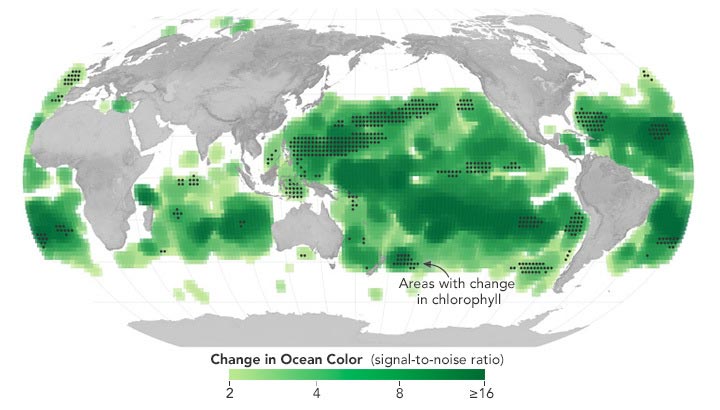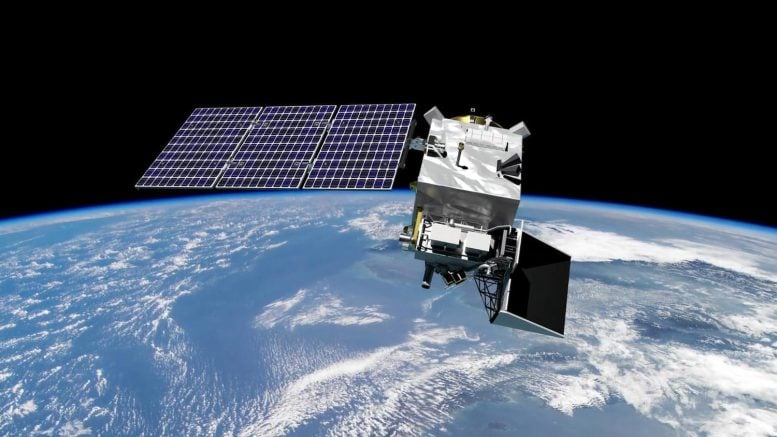
July 2002 – June 2022
Two decades of satellite measurements show that the sea surface is shading toward green.
The deep-blue sea is turning a touch greener. While that may not seem as consequential as, say, record warm sea surface temperatures, the color of the ocean surface is indicative of the ecosystem that lies beneath. Communities of phytoplankton, microscopic photosynthesizing organisms, abound in near-surface waters and are foundational to the aquatic food web and carbon cycle. This shift in the water’s hue confirms a trend expected under climate change and signals changes[1] to ecosystems within the global ocean, which covers 70 percent of Earth’s surface.
Key Findings from Recent Research
Researchers led by B. B. Cael, a principal scientist at the U.K.’s National Oceanography Centre, revealed[2] that 56 percent of the global sea surface has undergone a significant change in color in the past 20 years. After analyzing ocean color data from the MODIS (Moderate Resolution Imaging Spectroradiometer) instrument on NASA’s Aqua satellite, they found that much of the change stems from the ocean turning more green.
The map above highlights the areas where ocean surface color changed between 2002 and 2022, with darker shades of green representing more significant differences (higher signal-to-noise ratio). By extension, said Cael, “these are places we can detect a change in the ocean ecosystem in the last 20 years.” The study focused on tropical and subtropical regions, excluding higher latitudes, which are dark for part of the year, and coastal waters, where the data are naturally very noisy.
The Significance of Chlorophyll Changes
The black dots on the map indicate the area, covering 12 percent of the ocean’s surface, where chlorophyll levels also changed over the study period. Chlorophyll has been the go-to measurement for remote sensing scientists to gauge phytoplankton abundance and productivity. However, those estimates use only a few colors in the visible light spectrum. The values shown in green are based on the whole gamut of colors and therefore capture more information about the ecosystem as a whole.
A Unique Opportunity to Study Ocean Trends
A long time series from a single sensor is relatively rare in the remote sensing world. As the Aqua satellite was celebrating its 20th year in orbit in 2022—far exceeding its design life of 6 years—Cael wondered what long-term trends could be discovered in the data. In particular, he was curious what might have been missed in all the ocean color information it had collected. “There’s more encoded in the data than we actually make use of,” he said.
By going big with the data, the team discerned an ocean color trend that had been predicted[3] by climate modeling, but one that was expected to take 30-40 years of data to detect using satellite-based chlorophyll estimates. That’s because the natural variability in chlorophyll is high relative to the climate change trend. The new method, incorporating all visible light, was robust enough to confirm the trend in 20 years.
NASA’s PACE (Plankton, Aerosol, Cloud, ocean Ecosystem) spacecraft in orbit over Earth. Credit: NASA GSFC
Possible Explanations and Future Projections
At this stage, it is difficult to say what exact ecological changes are responsible for the new hues. However, the authors posit, that they could result from different assemblages of plankton, more detrital particles, or other organisms such as zooplankton. It is unlikely the color changes come from materials such as plastics or other pollutants, said Cael, since they are not widespread enough to register at large scales.
“What we do know is that in the last 20 years, the ocean has become more stratified,” he said. Surface waters[4] have absorbed excess heat from the warming climate, and as a result, they are less prone to mixing with deeper, more nutrient-rich layers. This scenario would favor plankton adapted to a nutrient-poor environment. The areas of ocean color change align well with where the sea has become more stratified, said Cael, but there is no such overlap with sea surface temperature changes.
More insights into Earth’s aquatic ecosystems may soon be on the way. NASA’s PACE (Plankton, Aerosol, Cloud, ocean Ecosystem) satellite, set to launch in 2024, will return observations in finer color resolution. The new data will enable researchers to infer more information about ocean ecology, such as the diversity of phytoplankton species and the rates of phytoplankton growth.
NASA Earth Observatory image by Wanmei Liang, using data from Cael, B. B., et al. (2023).
References:
“Abrupt shifts in 21st-century plankton communities” by B. B. Cael, Stephanie Dutkiewicz and Stephanie Henson, 29 October 2021, Science Advances.
DOI: 10.1126/sciadv.abf8593“Global climate-change trends detected in indicators of ocean ecology” by B. B. Cael, Kelsey Bisson, Emmanuel Boss, Stephanie Dutkiewicz and Stephanie Henson, 12 July 2023, Nature.
DOI: 10.1038/s41586-023-06321-z“Detection of anthropogenic climate change in satellite records of ocean chlorophyll and productivity” by S. A. Henson, J. L. Sarmiento, J. P. Dunne, L. Bopp, I. Lima, S. C. Doney, J. John and C. Beaulieu, 15 February 2010, Biogeosciences.
DOI: 10.5194/bg-7-621-2010“Increasing ocean stratification over the past half-century” by Guancheng Li, Lijing Cheng, Jiang Zhu, Kevin E. Trenberth, Michael E. Mann and John P. Abraham, 28 September 2020, Nature Climate Change.
DOI: 10.1038/s41558-020-00918-2
>>> Read full article>>>
Copyright for syndicated content belongs to the linked Source : SciTechDaily – https://scitechdaily.com/a-sea-of-change-climate-change-is-shifting-our-oceans-from-blue-to-green/
































